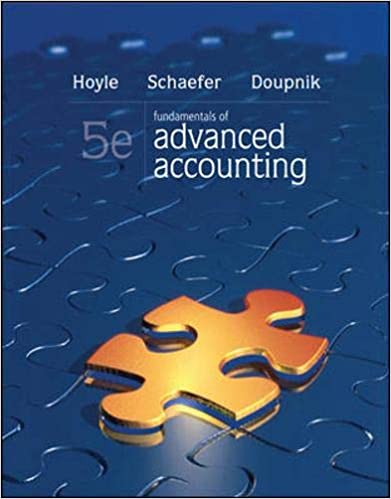
Fundamentals of Advanced Accounting 5th Edition by Joe Ben Hoyle,Thomas Schaefer,Timothy Doupnik
Edition 5ISBN: 978-1260575910
Fundamentals of Advanced Accounting 5th Edition by Joe Ben Hoyle,Thomas Schaefer,Timothy Doupnik
Edition 5ISBN: 978-1260575910 Exercise 33
Miller Company acquired an 80 percent interest in Taylor Company on January 1, 2011. Miller paid $664,000 in cash to the owners of Taylor to acquire these shares. In addition, the remaining 20 percent of Taylor shares continued to trade at a total value of $166,000 both before and after Miller's acquisition.
On January 1, 2011, Taylor reported a book value of $600,000 (Common Stock = $300,000; Additional Paid-In Capital = $90,000; Retained Earnings = $210,000). Several of Taylor's buildings that had a remaining life of 20 years were undervalued by a total of $80,000.
During the next three years, Taylor reported the following figures:

Determine the appropriate answers for each of the following questions:
a. What amount of excess depreciation expense should be recognized in the consolidated financial statements for the initial years following this acquisition
b. If a consolidated balance sheet is prepared as of January 1, 2011, what amount of goodwill should be recognized
c. If a consolidation worksheet is prepared as of January 1, 2011, what Entry S and Entry A should be included
d. On the separate financial records of the parent company, what amount of investment income would be reported for 2011 under each of the following accounting methods
(1) The equity method.
(2) The partial equity method.
(3) The initial value method.
e. On the parent company's separate financial records, what would be the December 31, 2013, balance for the Investment in Taylor Company account under each of the following accounting methods
(1) The equity method.
(2) The partial equity method.
(3) The initial value method.
f. As of December 31, 2012, Miller's Buildings account on its separate records has a balance of $800,000 and Taylor has a similar account with a $300,000 balance. What is the consolidated balance for the Buildings account
g. What is the balance of consolidated goodwill as of December 31, 2013
h. Assume that the parent company has been applying the equity method to this investment. On December 31, 2013, the separate financial statements for the two companies present the following information:

What will be the consolidated balance of each of these accounts
On January 1, 2011, Taylor reported a book value of $600,000 (Common Stock = $300,000; Additional Paid-In Capital = $90,000; Retained Earnings = $210,000). Several of Taylor's buildings that had a remaining life of 20 years were undervalued by a total of $80,000.
During the next three years, Taylor reported the following figures:

Determine the appropriate answers for each of the following questions:
a. What amount of excess depreciation expense should be recognized in the consolidated financial statements for the initial years following this acquisition
b. If a consolidated balance sheet is prepared as of January 1, 2011, what amount of goodwill should be recognized
c. If a consolidation worksheet is prepared as of January 1, 2011, what Entry S and Entry A should be included
d. On the separate financial records of the parent company, what amount of investment income would be reported for 2011 under each of the following accounting methods
(1) The equity method.
(2) The partial equity method.
(3) The initial value method.
e. On the parent company's separate financial records, what would be the December 31, 2013, balance for the Investment in Taylor Company account under each of the following accounting methods
(1) The equity method.
(2) The partial equity method.
(3) The initial value method.
f. As of December 31, 2012, Miller's Buildings account on its separate records has a balance of $800,000 and Taylor has a similar account with a $300,000 balance. What is the consolidated balance for the Buildings account
g. What is the balance of consolidated goodwill as of December 31, 2013
h. Assume that the parent company has been applying the equity method to this investment. On December 31, 2013, the separate financial statements for the two companies present the following information:

What will be the consolidated balance of each of these accounts
Explanation
"Equity Method:"
"The equity method of i...
Fundamentals of Advanced Accounting 5th Edition by Joe Ben Hoyle,Thomas Schaefer,Timothy Doupnik
Why don’t you like this exercise?
Other Minimum 8 character and maximum 255 character
Character 255


